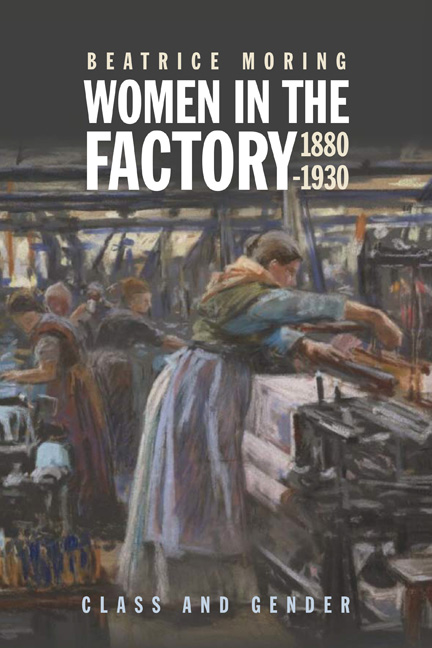Book contents
- Frontmatter
- Contents
- List of Illustrations
- Introduction – Why Women in the Factory?
- 1 Gender And Class – Male Unions, Political Movements and the Female Vote
- 2 Women in Industry: Work, Sectors, Age and Marital Status
- 3 Women, Earnings and the Household – Why the Factory?
- 4 Accidents, Compensation, Laws and Inspection
- 5 Middle Class Girls, Education and Entry into the Civil Service
- 6 The Female Factory Inspectors – How, Why and Who
- 7 Factory Inspection Activity
- 8 Class, Gender and Communication
- Conclusion
- Appendix 1 The Right for Women to Vote in National Elections
- Appendix 2 Women in the Workforce
- Appendix 3 Women, Work, Earnings and Family
- Appendix 4 Accidents, Workplace Acts and Regulations
- Appendix 5 Education
- Appendix 6 Female Inspectors
- Appendix 7 Inspectors, Activity
- Appendix 8 The Female Inspectors and Society
- Bibliography
- Index
2 - Women in Industry: Work, Sectors, Age and Marital Status
Published online by Cambridge University Press: 09 May 2024
- Frontmatter
- Contents
- List of Illustrations
- Introduction – Why Women in the Factory?
- 1 Gender And Class – Male Unions, Political Movements and the Female Vote
- 2 Women in Industry: Work, Sectors, Age and Marital Status
- 3 Women, Earnings and the Household – Why the Factory?
- 4 Accidents, Compensation, Laws and Inspection
- 5 Middle Class Girls, Education and Entry into the Civil Service
- 6 The Female Factory Inspectors – How, Why and Who
- 7 Factory Inspection Activity
- 8 Class, Gender and Communication
- Conclusion
- Appendix 1 The Right for Women to Vote in National Elections
- Appendix 2 Women in the Workforce
- Appendix 3 Women, Work, Earnings and Family
- Appendix 4 Accidents, Workplace Acts and Regulations
- Appendix 5 Education
- Appendix 6 Female Inspectors
- Appendix 7 Inspectors, Activity
- Appendix 8 The Female Inspectors and Society
- Bibliography
- Index
Summary
In preindustrial Europe, the family was the production unit in crafts and agriculture, particularly while production was on a small scale and the producers were the owners of the means of production. Even in sectors like mining where families hired themselves out to others, the tasks were divided between family members and together one earned a ‘family wage’. The capitalisation of agriculture in southern and eastern England and the gradual change of textile production into protoindustrial activity, where those who did the work only owned their skill and ability to work, went hand in hand with the disintegration of the family as a work unit. Over the nineteenth century, the mechanisation not only affected the opportunities of women but an increasing share of women and men became paid workers learning to tend machines rather than skilled craftsmen/women. An issue voiced with considerable concern by William Morris and the members of the Arts and Crafts movement. In Britain, the lack of statistical series registering economic activity before the mid-nineteenth century prevents us from pronouncing anything about the number of women who worked side by side with their husbands in craft shops or even mining. Considering the tendency of statisticians in other countries to only register the occupation of the household head, it is unlikely that we would have been provided with information about the activity of the wife and children even if there were data.
The advent of the mechanisation process and the opportunities to employ women and children only, and not together with a male household head, resulted in the rise of new problems and eventually the decision that the state needed to intervene and create protective legislation. Why? Because when these groups were no longer supervised by a father/husband, his replacement, the factory overseer, became the person with the right to disciplinary action. In addition, the factory owners introduced such a multitude of economic sanctions that only the lack of other feasible options could make such work attractive. With a population short of land or capital, a factory system of an unpleasant nature could be the only option for survival for members of the proletariat.
- Type
- Chapter
- Information
- Women in the Factory, 1880-1930Class and Gender, pp. 35 - 58Publisher: Boydell & BrewerPrint publication year: 2024



